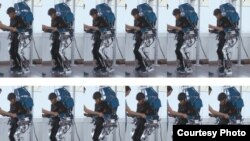The first clinical reports on technology that could allow paraplegics to walk again have been released, and researchers say the results suggest the future may offer significant recovery from otherwise paralyzing spinal cord injuries.
The study was released in Thursday's Scientific Reports.
The technology was designed by the Walk Again Project, or WAP, a non-profit international research consortium led by neuroscientist Miguel Nicolelis, director of the Duke University Center for Neuroengineering. The technology was put on display in 2014 when a man paralyzed from the waist down using a brain-machine interface, was able to control the movements of a robotic exoskeleton and perform the opening kick-off in the 2014 World Cup.
Training nerves to do new things
Since 2014, Nicolelis and his team have been training a group of eight patients, paralyzed from the waist down, with their brain-controlled system. According to the report, patients have "regained the ability to voluntarily move their leg muscles and to feel touch and pain in their paralyzed limbs. This, despite being originally diagnosed as having a clinically complete spinal cord injury - in some cases more than a decade earlier."
The team also reported that "the patients also regained degrees of bladder and bowel control, and improved cardiovascular function, which in one case resulted in a reduction in hypertension."
The WAP's unique training program involved training their patients "for a year on what they call the Walk Again Neurorehabilitation protocol" which used a combination of virtual reality and moving exoskeletons to give patients what Nicolelis calls "a very realistic walking illusion."
Each patient was fitted with a cap full of EEG (electroencephalogram) recording electrodes fitted over the brain areas controlling movement. In the virtual reality part of the training, the patients used an oculus rift head mounted VR display. They were "shown a three-dimensional avatar of a person, and were asked to imagine movements of their own bodies so they could make the avatar walk. All patients learned to use only their brain activity to move the avatar."
To make the illusion even more real, every time the avatar's foot touched the ground, the patients 'felt' the impact ...delivered through mechano-vibrating elements in a long-sleeved "tactile shirt."
Then the patients were put in what is known as a Lokomat, which looks like the lower body of a robot, and placed on a treadmill. They then used the same EEG cap to trigger the Lokomat movements and received the same tactile feedback they had been getting in virtual reality.
A third part of the training took patients off the Lokomat and into the same brain-controlled motorized exoskeleton custom demonstrated at the 2014 World Cup.
New nerve connections
The researchers say this combination of visual feedback and haptic (touch) feedback resulted in real changes in the EEG's of the patients' brains. Their theory is that the long-term training caused the patient's brain to literally reorganize itself. And forcing the muscles to exercise on the lokomat and in the exoskeleton may have "induced sprouting of new connections." The idea is that the training was able to activate "dormant nerves" that survived injuries that in some cases occurred up to 14 years earlier.
The team says the training is ongoing and that they are continuing to see improvement in their patients. Their goal now is to take their training show on the road and adapt it to other spinal cord injury centers in hopes of seeing their work replicated in a broader scale than the eight patients who participated in this initial project.









